Congratulations and thank you
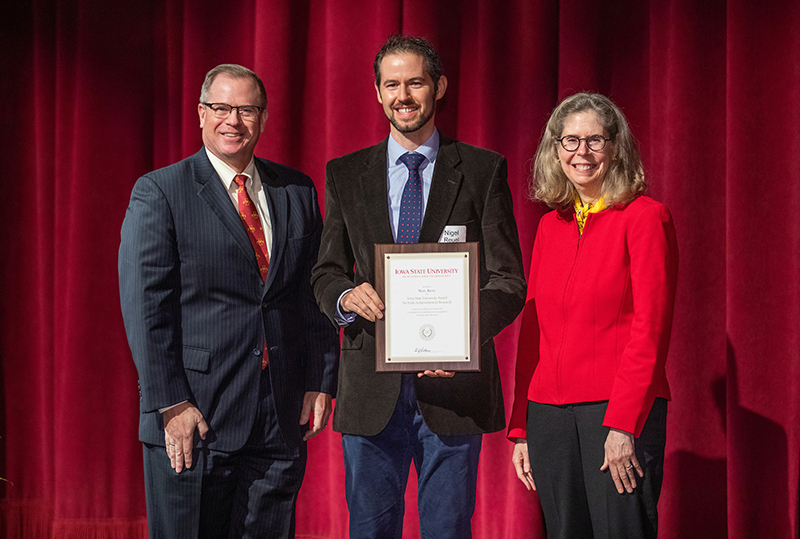
Associate professor of chemical and biological engineering Nigel Reuel (center) received Iowa State's Early Achievement in Research award from vice president for research Peter Dorhout and President Wendy Wintersteen. Reuel also received the university's award this year for Achievement in Intellectual Property. Photos by Christopher Gannon.
More than 70 Iowa State faculty and staff, recipients of the university's most prestigious awards for members of the campus community, were honored during an in-person ceremony Oct. 25 in the Memorial Union Great Hall. Pictured on the Inside homepage is animal science professor Daniel Loy receiving the Distinguished Service in Extension and Outreach award from vice president for extension and outreach John Lawrence and President Wendy Wintersteen. Loy, who also directs the Iowa Beef Center, was one of two double honorees this year, also receiving promotion to University Professor.
The full lineup of award recipients was announced in April.
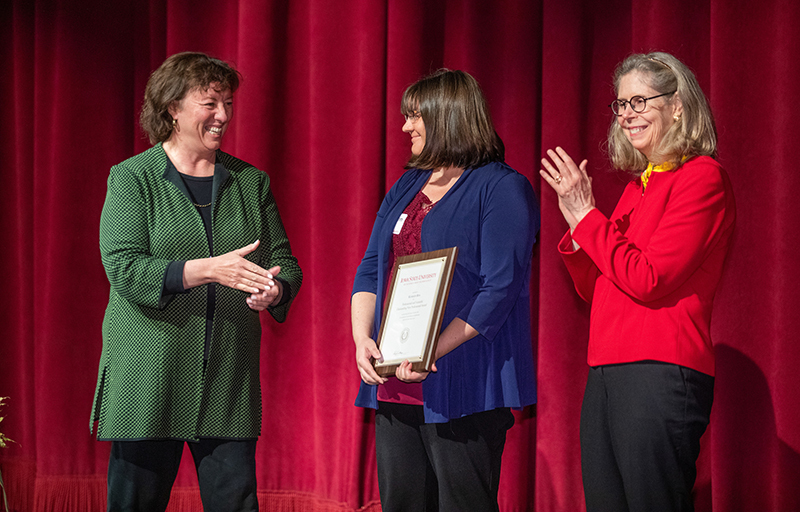
Kathleen Ross (center), a research scientist at the Nanovaccine Institute, received a Professional and Scientific Outstanding New Professional award from senior vice president for operations and finance Pam Cain and President Wendy Wintersteen.
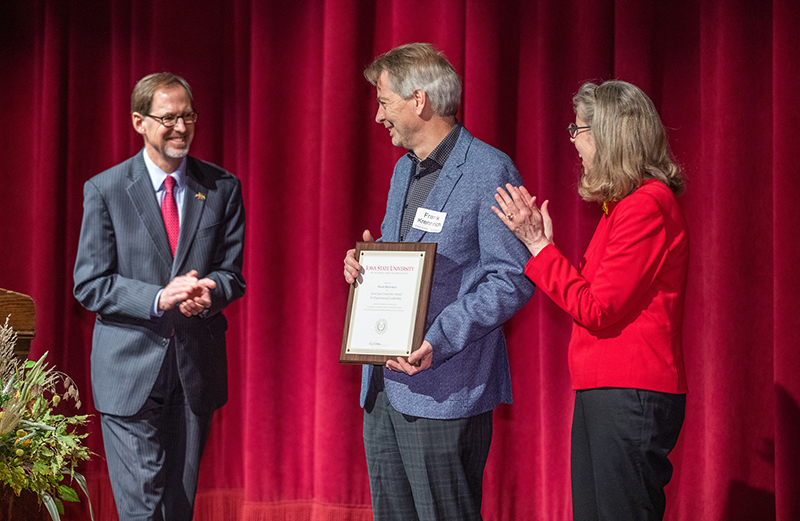
Physics professor Frank Krennrich (center) accepted Iowa State's Departmental Leadership award from senior vice president and provost Jonathan Wickert and President Wendy Wintersteen.
Time to review your benefits, as open enrollment launches Nov. 1
For more information
A live open enrollment webinar will be held Nov. 3 at 9 a.m. Presentation slides and a recording of the webinar will be posted to the open enrollment website following the event.
For questions about open enrollment or to set up a virtual or in-person meeting with a benefits office staff member, email benefits@iastate.edu.
The annual opportunity for employees to change their benefits choices starts Nov. 1 and runs for three weeks, closing on Nov. 19.
Open enrollment is the one time a year when employees can add, drop or adjust benefits such as health, life and dental insurance and the eyewear plan, without a qualifying life event. Employees who contribute to tax-free flexible spending accounts for health or dependent care expenses must sign up during open enrollment, as those elections do not carry over automatically to the next year.
Faculty and staff who don't plan to modify their coverage or use a flexible spending account still are encouraged to give their benefits a look during open enrollment because it's the most convenient time to identify desired changes.
Open enrollment is handled in Workday, and changes will be effective Jan. 1. Here's what employees need to know.
Health premiums up for most plans
Higher premiums for health care coverage is the only change to ISU Plan insurance programs in 2022. The increases announced last month will mean employees in the HMO plan will pay from $5 to $48 more per month. Some PPO policyholders will see smaller increases of $1 to $9 per month. Premiums are holding steady for PPO family plans.
The 2022 increases are the second year of a multiyear effort to counter rising costs in ISU's self-funded health plan, after a seven-year period without changes to premiums or other out-of-pocket costs.
Eyewear premiums drop
The Avesis vision discount program, which covers purchases of eyeglasses and contact lenses, will cost slightly less in 2022. Avesis rates fell 9% on all plan types, lowering monthly payments by up to $1.75 for the family plan. The lower rates are the result of the university benefits committee and the procurement office evaluating the market with a request for proposals.
Prior flex rules resume
Before selecting contribution levels for health and dependent care flex accounts, make sure to understand their regulations. Federal pandemic relief legislation brought changes, including a permanent expansion of reimbursable items for health care accounts. Other adjustments to flex account rules were temporary and are expiring at the end of 2021, under current federal rules.
The dependent care contribution limit increased to $10,500 per household for one year in 2021 but returns to the usual $5,000 in 2022. The maximum for a health care account remains $2,750.
Any money remaining in either a health or dependent care account at the end of 2021 can be used to reimburse eligible expenses throughout 2022. However, contributions next year will be subject to the prior rules, so a maximum of $550 of health flex funds remaining at the end of 2022 can carry forward to 2023. There is no cap on the amount of carryover for dependent care accounts, but leftover funds typically must be spent during a grace period that ends March 15, a timeline that will return for excess 2022 funds used for 2023 expenses.
Rules requiring a qualifying life event to alter flex account contributions were suspended in 2021. The requirement resumes in 2022, meaning open enrollment is the only guaranteed opportunity to set contribution levels.
How to make changes
Starting Nov. 1, a link to open enrollment 2022 will be in the announcements section of the launch page displayed when an employee logs in to Workday. It also will appear as an inbox task. Clicking "Let's Get Started" will open a page showing available benefits plans.
Choose "manage" to make changes, such as adding or removing a dependent. Choose "enroll" to add new coverage or set a flexible spending account contribution. Employees only have to click on plans they want to change or add.
After all changes are made, select "review and sign" to submit benefits choices and click "submit" on the final screen. Selections can be adjusted before the 5 p.m. deadline Nov. 19, but no changes are allowed after the open enrollment period ends.
Detailed instructions can be found in an open enrollment job aid.
Success often is in the details for winter session courses
The foundation of what makes a course successful doesn't change, even if the time frame does.
Iowa State piloted a 25-day online winter session last year, and this year's four-week option again gives students an opportunity to catch up or work ahead to meet their graduation requirements.
Questions?
Several instructors who taught during the inaugural winter session will take part in a Q&A session, "Winter Term: Faculty Appreciation and Collaboration," led by associate provost for academic programs Ann Marie VanDerZanden on Nov. 29 (11 a.m.-noon, 2010 Morrill Hall).
Instructors must determine how a course -- perhaps taught during the summer semester -- can be structured to help students learn. But for instructors who taught during the first winter session, success often came in paying attention to the details.
"I tried to have more checkpoints with students throughout the course," said Jan Lauren Boyles, associate professor in the Greenlee School of Journalism and Communication.
Boyles taught the 400-level course Communication Technology and Social Change asynchronously, but met with each student through Zoom during the first week. She also had a midterm check-in to allow tweaks.
Boyles said going from a five- to four-week course will require instructors to think further on the information they want to share with students.
Emmanuel Agba, teaching professor of mechanical engineering, also taught a 400-level computer-aided design course asynchronously last year. He said the shorter timespan doesn't change the material he covers, just the way he goes about it.
"I may have to do a longer lecture to cover the material, but I would cut it up into smaller sections," he said. "I don't want to have students sitting through one long lecture, but I also would have us doing some hands-on activities during that time."
Rethink delivery
Agba said he used the Center For Excellence in Learning and Teaching's (CELT) course template in Canvas to design his winter course. It benefited both the students and himself then and now.
"It helped me to better organize my class and put things into modules," Agba said. "I used to spend a lot of time in office hours when I taught the class face-to-face, but this semester I haven't had any one-on-one appointments with students. The information I offer in Canvas helps them do their work."
Agba opens all of the modules from the start of class, allowing students to work ahead. He can spend more time answering questions and providing help.
"This semester I have a student who is way ahead of me working on projects before those classes begin," he said. "She comes to class, takes notes and then goes back and fixes any mistakes."
He believes more students are working ahead, allowing for the material to be covered faster.
Providing the course as a winter session option also eliminated the waitlist for it that used to be the norm.
Course design
Teaching a class in four weeks presents challenges, but CELT offers assistance to those leading a condensed-format course.
One of the first questions instructional technology specialist Lesya Hassall asks any instructor is "What is important for this session?"
"You want to look at your learning objectives and determine if they are viable," said Hassall. "If your students are to learn during the compressed time -- and the key to learning is practice and feedback -- how do you structure the time to provide information, opportunity for practice and time for feedback?"
CELT recommends instructors "chunk" material into must-know, should-know and would-be-nice-to-know groups. Boyles sent students the syllabus before class began and had a video the first week laying out activities and assignments.
"It is really important to set the parameters from the first day," she said.
Hassall said many instructors develop a "hook" at the beginning of each class to get students engaged. That might be a funny meme followed by an interactive question or it could be music.
"We know students learn in different ways, and the more flexibility you have, and the more options you provide your students for learning, the more successful the course will be," said Lori Mickle, CELT instructional technology specialist.
Engaging students with one another gives them an opportunity to seek assistance from more than just the instructor. It puts the onus on the students to use their time wisely away from class so instructors can provide feedback about their learning, Mickle said.
Communication and organization
A clear plan of progression and communication in Canvas are key regardless of when a course is taught. Hassall said the winter session is not solely about delivery of content, but motivation, persistence, explanation and time management. Making sure students know what is expected, when assignments are due and how to access content helps a course run smoother.
Most instructors used virtual office hours through Webex or Zoom during the pandemic, which is helpful for winter session courses. Others use discussion boards or dedicated time for online chats to reach students in a variety of ways.
"In an online environment, I think you have to be more proactive as an instructor," Boyles said.
Proposed solar energy partnership goes to regents
Faculty professional development requests for the 2022-23 academic year and a 20-year lease with Alliant Energy for a proposed solar farm on university land near teaching farms south of Ames are on the agenda when the state Board of Regents meets Nov. 3-4 at the University of Northern Iowa. Open portions of the meeting will be livestreamed on the board's website, and meeting agenda items also are posted there.
Iowa State is sending professional development requests for 38 faculty to the board. This compares to 29 for the current year and 48 for last year. Because 12 of the 38 proposals are for the full 2022-23 academic year, the teaching replacement cost for the year is estimated at $0. The other 26 requests are for either fall or spring semester.
Iowa State's policy doesn't require a minimum years of service, but faculty must be employed at least halftime to be eligible for a professional development assignment. Priority is given to:
- Accomplished senior faculty.
- Faculty seeking competitive fellowships, such as a Fulbright award.
- Faculty who haven't received a professional development assignment in at least five years.
Solar farm for the ag farms
As proposed, Alliant Energy would begin installing a solar farm sometime next year on land west of the ISU compost facility on 260th Street. By late 2023, the solar farm would start producing electricity and, instead of rent, the university would earn federal Clean Air Act renewable energy credits, which it would use for electricity at the teaching and research farms in the south State Avenue area. Using this green energy option helps the university meet its sustainability goals.
Alliant Energy would construct, operate, maintain and own the solar panels and related equipment.
Athletics parking plans
Iowa State will present two parking expansion plans for the facilities committee and full board approval. Both relate to athletics department plans at and near the Iowa State Center. The first replaces existing lots north of Scheman and west of Fisher Theater and expands them into an L-shaped lot that adds 380 parking stalls to this corner. The project also adds a small lot between Fisher and Stephens facilities with a dedicated drop-off area. The estimated cost is $5.5 million, to be covered by athletics department funds. If approved, construction could begin immediately, with the new lots completed next summer.
The second project converts and expands football gameday grass lot G7 into a gravel lot with a capacity for 330 RVs and a concrete parking pad and electrical service at each stall. Also in the project is a pedestrian path, including a bridge over Worle Creek, to link grass parking lots along South 16th Street to this area. The estimated cost is $8.1 million. As scheduled, the RV lot and the pedestrian bridge over University Boulevard both would be ready for the start of the 2022 football season.
Regular reports
Primarily through its committee structure, the board will receive numerous reports this month. They include:
- Academic affairs committee (10:30 a.m. Wednesday): Academic program review annual report, biennial faculty activities report, Lakeside Laboratory annual report.
- Campus and student affairs committee (1 p.m. Wednesday): Campus safety and security annual report, student health and wellness report.
- Full board (9:15 a.m. Thursday): Fall enrollment report, economic development and technology transfer annual report (presented by business customers of regent universities).
The board will receive public comments before it adjourns for the day on Wednesday, or at around 5 p.m. (Adjournment is estimated at 5:45 p.m.) The deadline to register to address the board is 10:30 a.m. Nov. 1.
Shredding for bedding effort turns to textile scraps
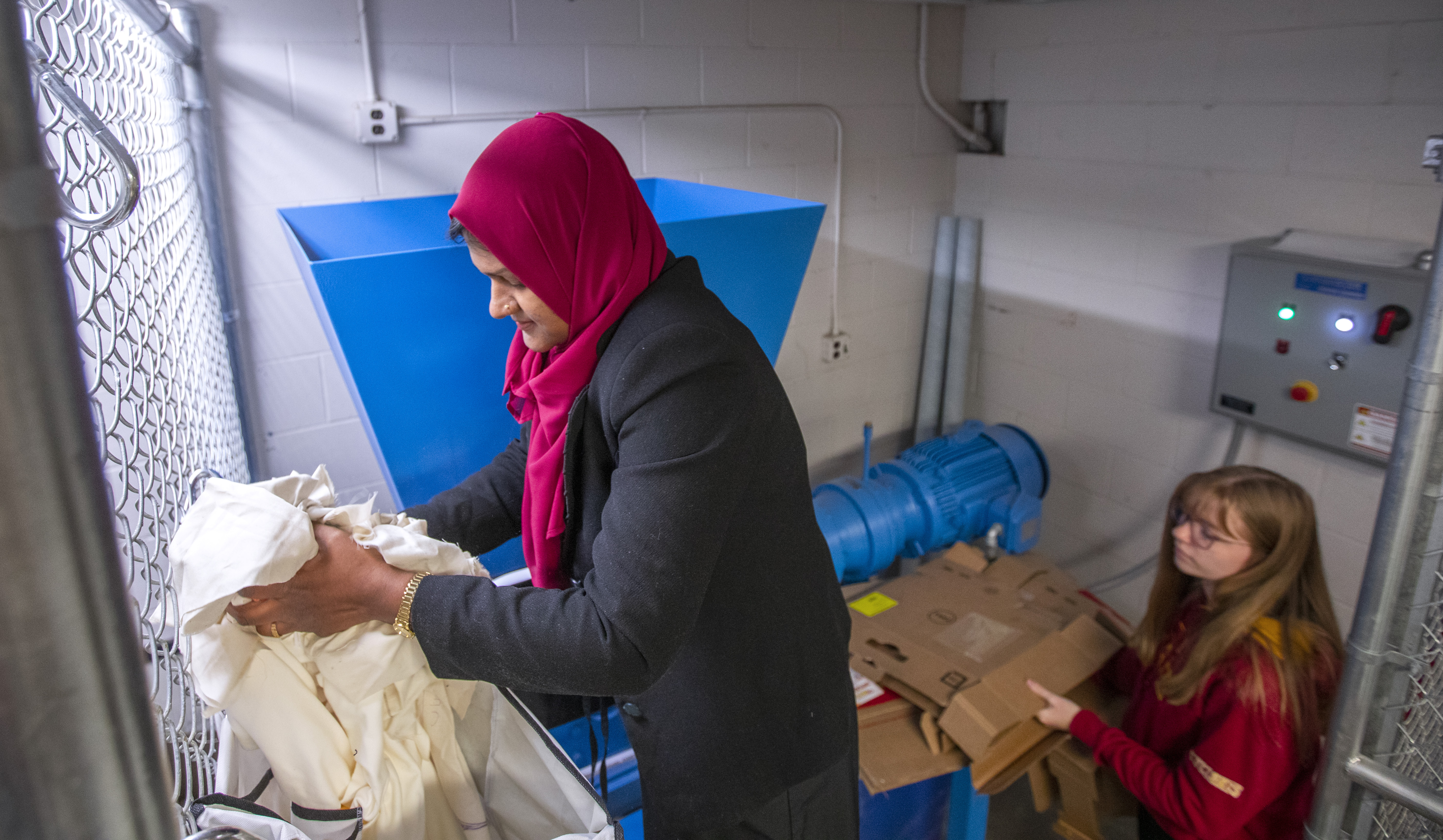
Doctoral student Farhana Momotaz, left, and senior Katie Wild prepare fabric and cardboard to be shredded in MacKay Hall. They are part of a project to collect textile waste from apparel production studios and shred it to use as animal bedding or compost fodder. Photos by Christopher Gannon.
Piles of discarded fabric from mocked-up samples and leftover scraps are unavoidable in Iowa State's apparel design studios, and Rachel Eike knows where unwanted textiles end up far too often.
"Textiles are a massive contributor to landfill waste," said Eike, an assistant professor of apparel, events and hospitality management whose research includes textile sustainability.
That's why Eike has spearheaded gathering textile waste produced in LeBaron Hall to sort out and shred natural fabrics -- most of it unprinted, unbleached cotton -- to be used either directly in the university's composting facility or first as animal bedding in ISU cattle stalls and then as compost fodder.
With the help of student volunteers, the effort diverts as much as 125 pounds of textiles per year from the landfill, Eike said. Until this summer, when she purchased a small industrial shredder, they had been shredding the discarded textiles by hand since spring 2019, using scissors and small industrial cutting knives
"We're trying to lead by example. If we care about where textiles end up, hopefully our students will, too," she said.
Cardboard project pending
Eike's initiative follows the lead of a three-month 2019 pilot, when cardboard collected for recycling campuswide was shredded for use as bedding at the beef nutrition farm a few miles northwest of Ames. In both cases, the shreds worked well in stalls and subsequently in the compost facility, contributing to the university's zero-waste goal to divert 85% of campus waste from landfills by 2025.
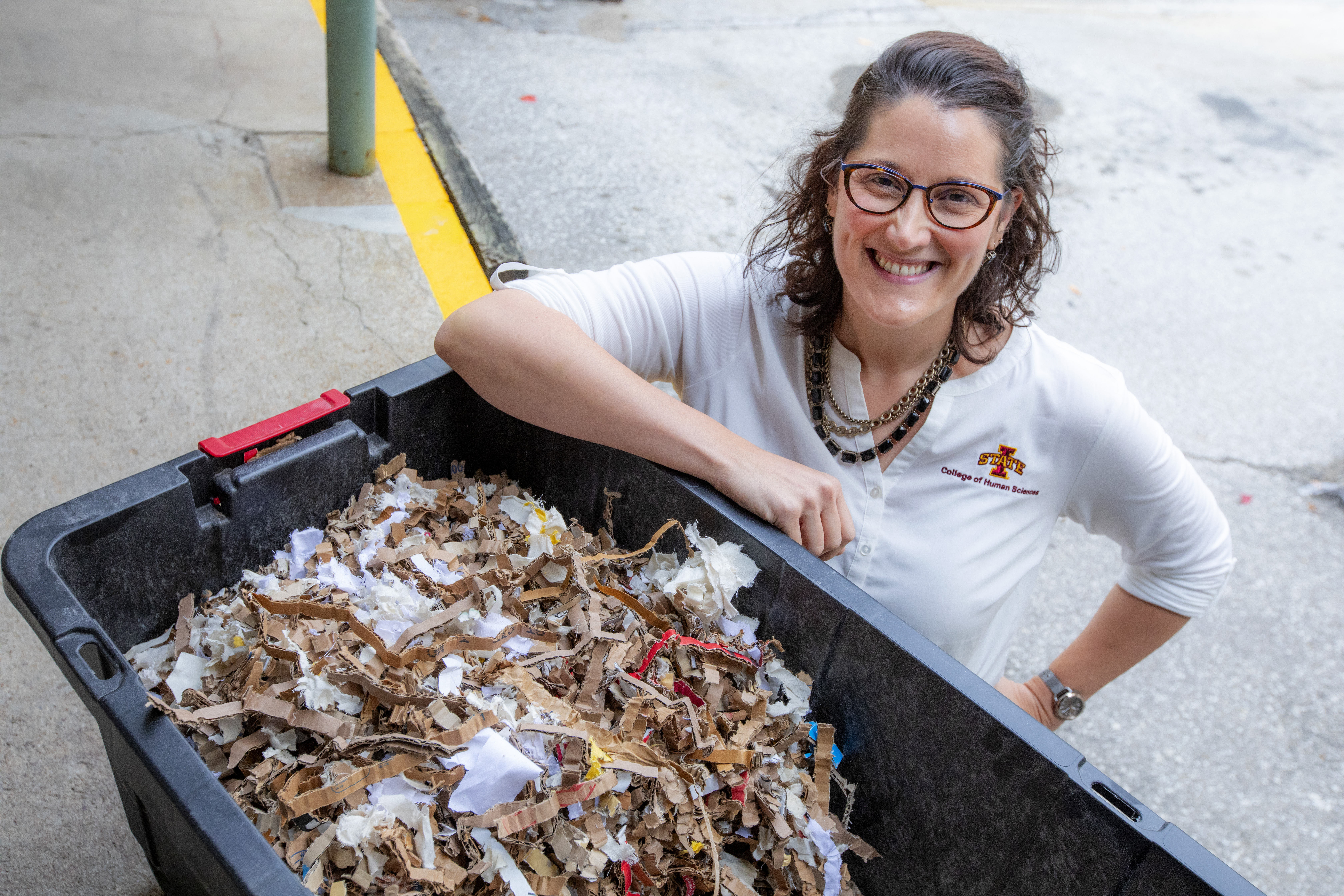
Rachel Eike, assistant professor in apparel, events and hospitality management, has led a project to collect and shred textile waste from the department's apparel production studios.
"We're showing there's treasure in some of the things we're throwing away," said recycling and special events coordinator Ayodeji Oluwalana, who oversees the zero-waste initiative and coordinated the cardboard shredding project.
To shred cardboard for bedding campuswide on a permanent basis, the program needs to be more financially sustainable. A simple building and a suitably sized shredder would cost roughly $1 million. Annual operation costs are estimated to run a deficit of about $70,000, procurement director Cory Harms said.
One unknown with the operating cost projection is whether there would be a market for selling bedding. The university generated more than 200 tons of recycled cardboard in fiscal year 2020 and potentially could take in cardboard from other local institutions to sell the shredded product to livestock producers.
"There may be a better revenue stream than we know, but we don't know what the demand would be because it's a new use for cardboard," Harms said. "I think there's potential, but it's taking a leap and that's difficult."
The financial impact isn't the only consideration, Harms said. Being a leading innovator in reusing cardboard has value, especially at a time when even recycled cardboard ends up in landfills sometimes due to challenging market conditions.
"There's a big carbon impact in moving this stuff to maybe be recycled," he said.
Beyond shredding
Eike's project points to another possible model for a shredding initiative: smaller on-site hubs. When the team shreds textiles once a week, they fill any remaining space in the containers with shredded cardboard. Oluwalana said data from this differing approach could be useful in a grant application to help pay for the larger-scale cardboard diversion program. And it may serve as an inspiration, too.
“I hope initiatives like this will continue to stir waves of behavioral changes when it comes to what people consider waste, leading to the attainment of a zero-waste campus," Oluwalana said.
While the shredding will continue, so will identifying other ways to repurpose cast-off cloth, Eike said. A doctoral student is trying to make an alternative to leather from discarded cotton and paper materials, and another student group is cutting discarded T-shirts into yarn for creating upcycled products.
"I'd love to bring these shreds in as a resource and have students experiment with it," she said.
Other efforts aim to prevent new textiles from needing to be produced. Students organized a fabric swap in September and are planning a clothing swap around winter break, Eike said.
"They're trying to find life from things that are discarded or unwanted," she said.
For car trouble or a walk in the dark, help is available
Shrinking daylight this time of year means more faculty and staff may be crossing campus or returning to their vehicles in the dark. The ISU Police department offers several options to enhance personal safety.
ISU Guardian is a mobile app that can be used by anyone with a Net-ID on or off campus. A user sets a timer for the estimated length of time it will take to reach their car, home or other destination. Their designated "guardian" receives a notification to follow a GPS location on a map and will be alerted if that person doesn't make it to their destination on time. ISU Police can be designated as guardian from 6 p.m. to 5:30 a.m.
"If you need assistance, the button is right there on your phone to let your guardian know or to contact ISU Police," said Natasha Greene, ISU Police engagement and inclusion officer. "It's a way to speed up the process to get help if you need it."
The app also has a contact list of emergency and non-emergency personnel, push notifications about campus activity and crime, and a tip button for easy submissions to ISU Police.
SafeRide offers free transportation throughout central campus and other university areas between 6 p.m. and 5:30 a.m. all year. The service extends to visiting scholars, postdocs and their families in addition to faculty, staff and students. To use SafeRide, call 294-4444, or download the app. Uniformed student community service officers fulfill requests in ISU-marked vehicles.
ISU Help Van can assist faculty, staff and students with a range of vehicle issues on campus, from providing a jump-start to a shovel to clear snow. It is available 24/7, also by calling 294-4444.
Personal safety
Greene said trying to eliminate whatever is causing concern can be helpful. If walking at night is an issue, she recommends carrying a flashlight. It also can reduce the likelihood of slipping or falling, especially during winter months.
"Always be aware of your surroundings," Greene said. "It's not because something bad is going to happen to you, but at Iowa State we like to see a community care model where people are paying attention enough that they notice if someone else needs help."
The effectiveness of self-defense tools vary from person to person. The best ones are usually those available to a person at all times like their hands, elbows, knees and feet, Greene said.
"If you're going to have any kind of safety tool, it needs to be easily accessible, you need muscle memory to use the tool and, most importantly, you need to be able to retain the tool so it can't be used against you."
Classes
ISU Police offers a free self-defense course to faculty, staff and students that focuses on situational awareness, personal self-defense devices, and general physical skills and techniques.
Greene said groups of people are preferred, and groups are asked to give two weeks' notice and multiple dates for the course. Requests can be emailed to isupdoutreach@iastate.edu.
Groups also can request presentations like "Know Your Rights: Harassment 101" or "How to Address Your Fears" from engagement and inclusion officers. Greene said these presentations are gaining popularity and can help in situations such as verbal altercations.
Cheese with school spirit
Earlier this month, the Iowa State University Creamery announced its second foray into cheese production, a limited-edition, cyclone-shaped and cardinal-waxed, aged cheddar cheese.
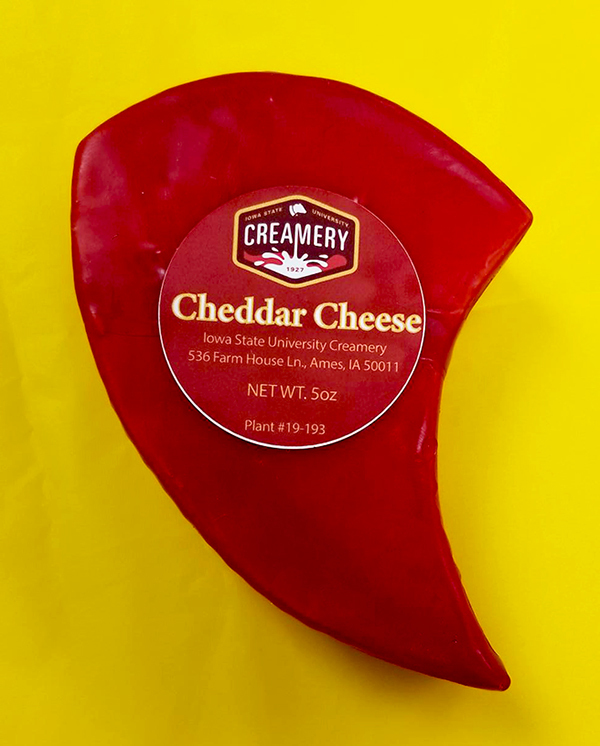
Cyclone cheddar cheese
The Creamery has been selling fresh cheddar cheese curds intermittently since April in its retail location, 2955 Food Sciences. During Homecoming week, it sold out of a limited first release of about 30 chunks of cheddar cheese. Pieces are sold by weight, ranging in price from approximately $6 to $16.
The next release is scheduled for the week of Nov. 15, also in the Food Sciences retail location.
"Cheese always was planned for the ISU Creamery. It just took a while for us to get there," said Stephanie Clark, Virginia M. Gladney Professor in the department of food science and human nutrition. "Whether they're making ice cream or cheese, our students are gaining valuable hands-on experience in core concepts of sanitation, chemistry, microbiology and engineering.
"Preparing them for careers beyond ISU is the primary goal of the ISU Creamery," she said.
The cheese
The Creamery's cheddar cheese starts out as whole milk. Under Clark's direction, students commit to a one-and-a-half-day process of monitoring culture and enzyme activity and salting the curds, before pressing them into hoops overnight and cutting them into cyclone shapes the next morning. They hand-dip the minimum 5-ounce pieces of fresh cheddar cheese in cardinal wax, and the waxed cheese blocks are aged a minimum of eight weeks prior to sale.
Partnering with summer sausage
The Creamery also is offering its ISU cheddar cheeses through the Block & Bridle club's annual summer sausage and cheese fundraiser. Orders close Nov. 13; pick-up is Nov. 16-17.
Take a journey 'to the dark cyde' with the symphony orchestra
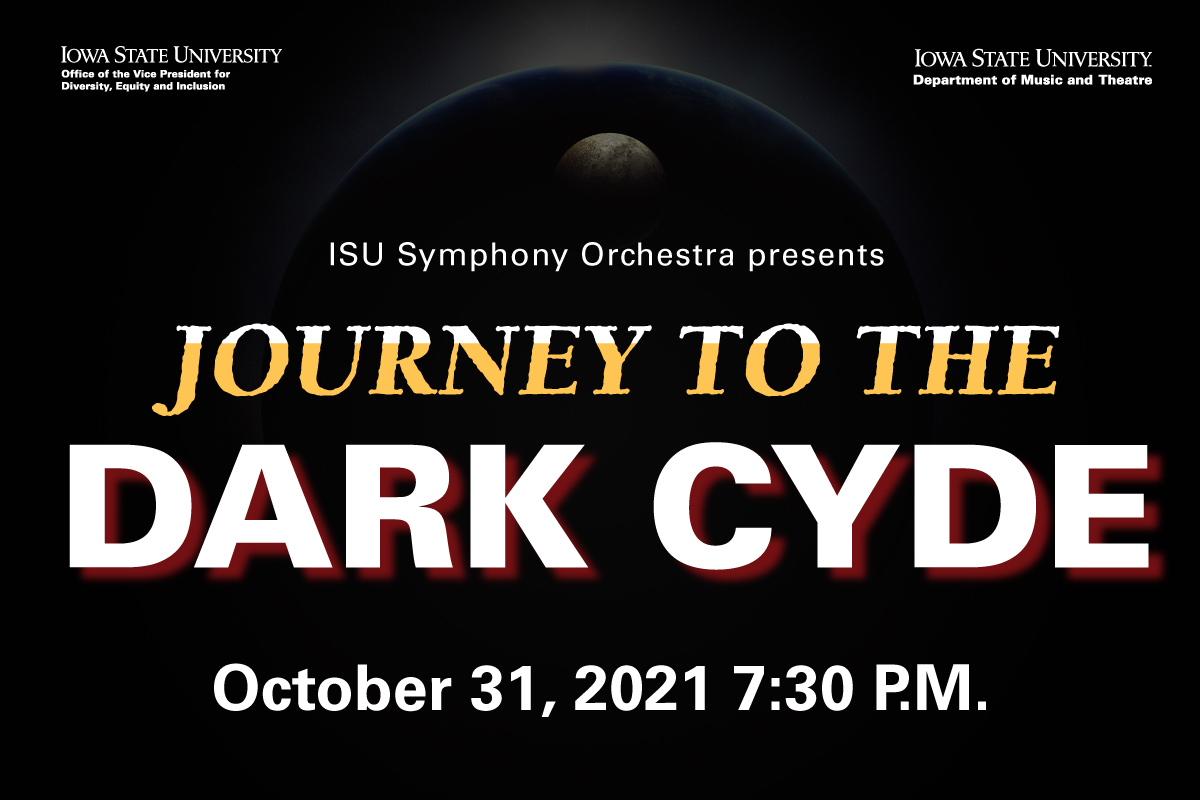
The ISU Symphony Orchestra will present a program that's fun for the whole family, playfully bringing together Halloween spirit and the hallowed sounds of popular movie soundtracks during its Oct. 31 concert "Journey to the Dark Cyde" in Stephens Auditorium. It begins at 7:30 p.m.
The concert will feature movie soundtracks from award-winning films and box office hits such as "Star Wars," "Star Trek," "Pirates of the Caribbean" and "Crouching Tiger, Hidden Dragon," with a cello concerto featuring cello soloist George Work, an ISU music professor.
If the mention of "Star Wars" makes you feel like bringing your favorite little one in a Baby Yoda costume, you're in luck. Part of the evening's fun for children and adults includes a communitywide costume contest.
Tickets are $10 for adults and $5 for children and are available through the Stephens Auditorium Ticket Office.
"COV-stume" contest encourages masks, creativity
Jonathan Govias, conductor of the ISU Symphony Orchestra and director of orchestral activities, said students came up with the costume idea when they learned the fall concert was scheduled for Oct. 31.
"They asked if they could wear costumes and I said, 'If we're going to wear costumes, we need to do it with a little more purpose than just wearing costumes,'" Govias said. "And that's where the idea of what we're calling the, forgive me, COV-stume contest was born."
The contest aims to take an element of the COVID-19 pandemic that has been burdensome at times -- mask wearing -- and give it a celebratory and fun feel, Govias said.
"We want to encourage people to wear a mask and the costume component is to show us how creatively you can integrate a mask into your Halloween get-up," Govias said. "Some of our musicians will be onstage in costume. The idea is just to have a good time, play some music and try to make some lemonade out of all the lemons we've been handed in the last year."
A communitywide event
While the symphony orchestra performed in 2020, with physically-distanced concerts in Howe Hall, operating as a smaller orchestra limited the musical selections. Govias said students are excited about the concert's movie soundtrack theme.
"Our students' ambition is to perform energetic and exciting music in front of crowds, and they were performing small orchestra music in front of very small crowds last year," Govias said. "The payoff was just never there. The programming for this concert was my desire to give our students something they could really get their teeth into and would just be a whole lot of fun."
Both the concert and costume contest are open to the public. The symphony orchestra selected Stephens Auditorium as the venue to allow for physically-distanced seating arrangements.
"We want to make this a communitywide initiative," Govias said. "The intention is that families can go trick-or-treating and then come to the concert. It's an hourlong show so they can be home on time for a school night."
In support of his students, Govias also plans to wear a costume, though he said it will be low-key.
"I'm keeping it a secret," he joked. "It won't just be me wearing a tailcoat suit as a penguin."
To enter the costume competition, participants can post a photo of their costume on Instagram with the hashtag #cov_stume and tag the @isusymphony Instagram account. Contest categories include Greek societies, residence floors or blocks, university clubs, university intramural or athletics teams, family and individual. Prizes for each division have been donated by university and community partners.
